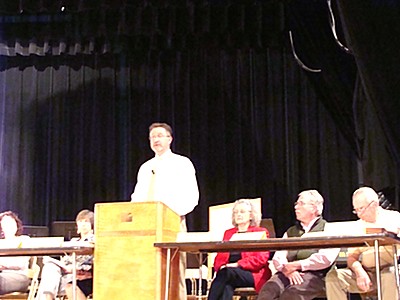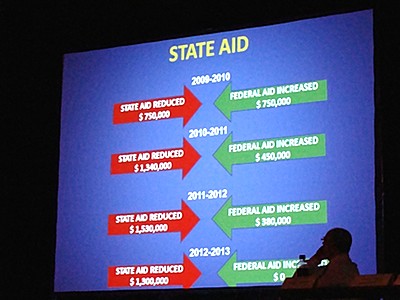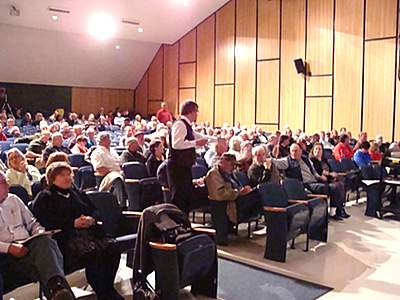- By Dan Veaner
- News
 Print
Print  More than 150 people came to Lansing Middle School to learn about the sewer Tuesday. This was the first major information session in a series of events planned to present the facts on the $10.8 million project. Town and school officials, sewer committee members, and the town attorney and engineer gave a presentation, followed by two hours of questions in an attempt to get all the facts to the public and assuage concerns based on rumors.
More than 150 people came to Lansing Middle School to learn about the sewer Tuesday. This was the first major information session in a series of events planned to present the facts on the $10.8 million project. Town and school officials, sewer committee members, and the town attorney and engineer gave a presentation, followed by two hours of questions in an attempt to get all the facts to the public and assuage concerns based on rumors.Miller began by reading an excerpt from a sewer committee report from an earlier project in 1995. The report noted that Lansing has been aware of the need for sewer since the 1960s. At least four projects have been proposed for the Town since that time.
In 2007 the Lansing Town Board decided not to even put the last project to a vote because the $18.2 million project that would have required a trunk line to convey effluent from the Town through the Village of Lansing to the Cayuga Heights treatment plant would have been too expensive. The estimated cost of that project would have been $854 per year for a home that is hooked up to the sewer. That sewer committee had stated a goal of getting that cost down to an annual $548 by soliciting loans and donations, but were unable to do so.
The current project will cost property owners just over half that cost. It achieves it in part because it is a town-wide Article 12C (excluding the Village of Lansing) sewer district, commitments (and interest for new projects) by new developers, and a state grant.
 Town Engineer David Herrick explains the makeup of the sewer system
Town Engineer David Herrick explains the makeup of the sewer systemThe plan uses two payment tiers. Tier 1 includes an initial service area in South Lansing, as well as existing sewer districts on Warren and Cherry Roads that would be folded into the larger district. The estimated typical annual cost for households within the service areas is $474.74, which includes debt payment, a treatment operation & maintenance charge, and a capital replacement charge. The capital debt charge would disappear after the loan is paid back in 30 years. Tier 2 property owners would pay $23.65 per $100,000 of assessed value, which for most homeowners would be in the range of about $50 per year.
Miller says the time for sewer is now for a number of reasons, including a $2.537 million state grant. The project must show substantial progress this year to keep the grant. She says the cost of building is still low because of the recovering economy, and low interest rates are available. Lansing has qualified for a subsidized loan, but Miller says the town may not qualify in the future because of increasing wealth. She noted that denser development made possible by sewer will help offset revenue losses, particularly in the Lansing Central School District, from the declining value of the Cayuga Power plant at Milligan Station.
 Shrinking state aid and power plant revenue threater to balloon school taxes unless the tax base is expanded
Shrinking state aid and power plant revenue threater to balloon school taxes unless the tax base is expandedLansing School Business Administrator Mary June King explained that the plummeting power plant value is the equivalent of 429 $200,000 homes suddenly evaporating from the tax base, forcing taxes higher for the remaining homes. She said that projected growth because of the sewer would not impact the school district negatively. She said that 65 new students would have little to no impact on staffing.
Miller noted that the State can require municipalities to build sewer, and said it would certainly be a lot more expensive if that were to happen ten years in the future. She said a pro-active project now would be less costly to residents.
Sewer Committee member Tom Jones demonstrated how the sewer will reduce alarmingly rising school taxes. School taxes are going to go up, but with a larger tax base Jones showed figures that he says are conservatively calculated. The calculation showed that Tier 2 property owners would pay 23 cents per thousand dollars of assessed value, but save 37 cents on school taxes because of additional growth.
Questions were written on cards that were passed to the stage to be answered. Residents were concerned about the cost, and the amount of time allowed before Tier 1 properties are required to hook up to the system. The committee was asked about the projected capacity of a treatment plant planned to be located on Portland Point, and the ability to expand its capacity in the future.
One resident asked for figures on how many septic systems in Lansing have failed. Miller said she asked the Tompkins County Health Department for those statistics six months ago, but has yet to receive an answer. She said she plans to submit a Freedom Of Information Law (FOIL) request to force the county to provide the information.

Residents asked about how the two tier system had been formulated, and how the breakdown of payments had been developed. Some wanted to know why dense areas have been ommitted from the initial service area. Town engineer David Herrick explained it was a matter of cost, and Miller added that once a sewer exists it is easier to get grants to add neighborhoods to the service area.
Other questions were about who gets to vote and when, how the Town will guarantee costs won't double, what properties are exempt from sewer costs, controlling the cost of the initial project, and whether the plant would smell.
A copy of the presentation and the Map Plan Report are on the Town Web site. Video of the presentation will be posted there as well, probably next week. An abbreviated copy of the Map Plan Report was mailed to all property owners within the proposed district, but the copy on the Web site contains two appendixes that outline the cost to each property, arranged alphabetically by owners' names.
So far two more public information sessions have been scheduled in the Lansing Town hall for May 22nd and June 12, both at 7pm. In addition public hearings will be scheduled, as well as neighborhood information sessions hosted by residents.
v9i16



